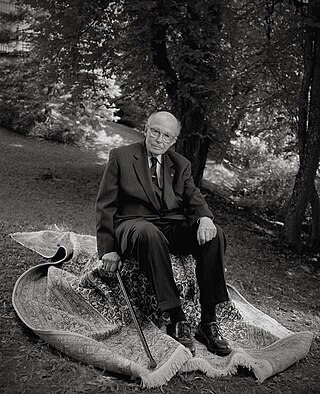
Otto von Habsburg was the last crown prince of Austria-Hungary from 1916 until the dissolution of the empire in November 1918. In 1922, he became the pretender to the former thrones, head of the House of Habsburg-Lorraine, and sovereign of the Order of the Golden Fleece upon the death of his father. He resigned as Sovereign of the Golden Fleece in 2000 and as head of the Imperial House in 2007.

Ferdinand I was Emperor of Austria from March 1835 until his abdication in December 1848. He was also King of Hungary, Croatia and Bohemia, King of Lombardy–Venetia and holder of many other lesser titles. Due to his passive but well-intentioned character, he gained the sobriquet The Benign or The Benevolent.

Johann Josef Wenzel Anton Franz Karl, Graf Radetzky von Radetz was a Czech nobleman and Austrian field marshal. He served as chief of the general staff in the Habsburg monarchy during the later period of the Napoleonic Wars and afterwards began military reforms. A disciplined and fair man, he was so beloved by his troops that he was known as Vater ('Father') Radetzky. He is best known for the victories at the Battles of Custoza and Novara during the First Italian War of Independence.
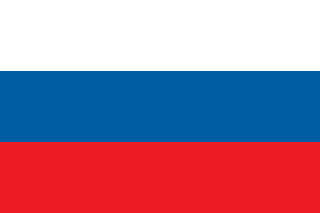
The Duchy of Carniola was an imperial estate of the Holy Roman Empire, established under Habsburg rule on the territory of the former East Frankish March of Carniola in 1364. A hereditary land of the Habsburg monarchy, it became a constituent land of the Austrian Empire in 1804 and part of the Kingdom of Illyria until 1849. A separate crown land from 1849, it was incorporated into the Cisleithanian territories of Austria-Hungary from 1867 until the state's dissolution in 1918. Its capital was Ljubljana.
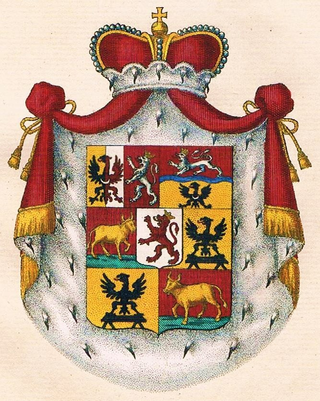
The House of Auersperg is an Austrian princely family, which once held estates in the Holy Roman Empire. The princely family of Auersperg was a junior branch of the comital line of Auersperg from Carniola, one of the hereditary Habsburg duchies in what is now Slovenia. The Auerspergs were raised to princely status in 1653, and they became "immediate" princes of the Holy Roman Empire in 1664. The princes of Auersperg also held at various times the duchies of Münsterberg and Gottschee. Their territories were mediatised by Austria and Baden in 1806, and the family is counted as high nobility.
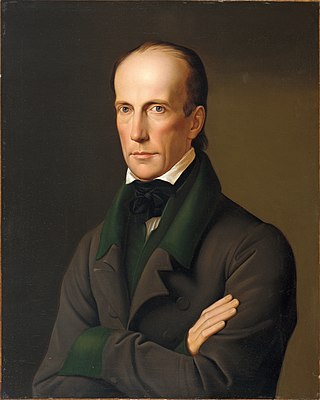
Archduke John of Austria, a member of the House of Habsburg-Lorraine, was an Austrian field marshal and imperial regent (Reichsverweser) of the short-lived German Empire during the Revolutions of 1848.

Johann Ludwig Joseph, Graf von Cobenzl was a diplomat and politician of the Habsburg monarchy.

Johann Philipp, Graf von Cobenzl was a statesman of the Habsburg monarchy and the Austrian Empire.

The Counts of Gorizia, also known as the Meinhardiner, were a comital, princely and ducal dynasty in the Holy Roman Empire. Named after Gorizia Castle in Gorizia, they were originally "advocates" (Vogts) in the Patriarchate of Aquileia who ruled the County of Gorizia (Görz) from the early 12th century until the year 1500. Staunch supporters of the Emperors against the papacy, they reached the height of their power in the aftermath of the battle of Marchfeld between the 1280s and 1310s, when they controlled most of contemporary Slovenia, western and south-western Austria and north-eastern Italy mostly as (princely) Counts of Gorizia and Tyrol, Landgraves of Savinja and Dukes of Carinthia and Carniola. After 1335, they began a steady decline until their territories shrunk back to the original County of Gorizia by the mid 1370s. Their remaining lands were inherited by the Habsburg ruler Maximilian I.

Ulrich II, or Ulrich of Celje, was the last Princely Count of Celje. At the time of his death, he was captain general and de facto regent of Hungary, ban (governor) of Slavonia, Croatia and Dalmatia and feudal lord of vast areas in present-day Slovenia, Croatia, Bosnia, Austria, and Slovakia. He was also a claimant to the Bosnian throne. He was killed by agents of the Hunyadi clan under unknown circumstances, which plunged Hungary into civil unrest that was resolved a year later by the sudden death of king Ladislas the Posthumous and the election of Matthias Corvinus, the son of John Hunyadi and Ulrich's son-in-law, as king. Ulrich's possessions in the Holy Roman Empire were inherited by Emperor Frederick III, while his possessions in Hungary were reverted to the crown.
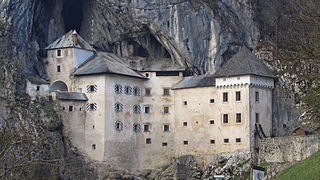
Predjama Castle is a Renaissance castle built within a cave mouth in south-central Slovenia, in the historical region of Inner Carniola. It is located in the village of Predjama, approximately 11 kilometres from the town of Postojna and 9 kilometres from Postojna Cave.

Franz Ludwig Johann Baptist Count von Meran, Baron von Brandhofen was an Austrian nobleman and Viennese courtier.

The House of Khevenhüller is the name of an old and important Carinthian noble family, documented there since 1356, with its ancestral seat at Landskron Castle. In the 16th century, the family split into the two branches of Khevenhüller-Frankenburg, Imperial Counts from 1593, and Khevenhüller-Hochosterwitz, raised to Imperial Counts in 1725 and, as Khevenhüller-Metsch, to princely rank (Fürsten) in 1763. The family belongs to high nobility.

Philipp Ludwig Wenzel von Sinzendorf was an Austrian diplomat and statesman who for nearly four decades served as Court Chancellor responsible of foreign affairs of the Habsburg monarchy.

Johann Karl Philipp, Graf von Cobenzl was an 18th-century politician in the Habsburg monarchy. He was minister plenipotentiary of the Austrian Netherlands in Brussels under Empress Maria Theresia from 1753 until his death in 1770.

Johann Georg Adam Graf von Starhemberg, since 1765 Fürst von Starhemberg was an Austrian diplomat, minister, chief chamberlain and close confidant of Empress Maria Theresa.
The Babonić family was an old and powerful Croatian noble family from the medieval Slavonia whose most notable members were Bans (viceroys) of Slavonia and Croatia.

Frederick I of Celje also Frederick I of Cilli, was a Styrian free noble who became the first Count of Celje, founding a noble house that would dominate Slovenian and Croatian history in the first half of the 15th century.
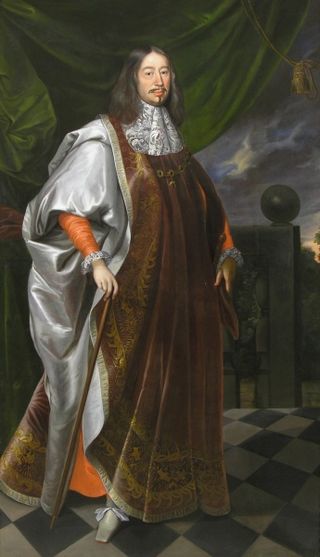
Johann Adolf of Schwarzenberg was the first Prince of Schwarzenberg. A diplomat in the service of the Habsburgs, he was a member of the prestigious House of Schwarzenberg.

Johann Maximilian von Lamberg was an Austrian nobleman, diplomat and courtier. In the service of the Habsburgs, he excelled in the peace negotiations at the end of the Thirty Years' War, resulting in the Peace of Westphalia. Later in high offices he was one of the influential figures of the imperial court. In addition to gaining the title of count (1641), he expanded the family property in various parts of the Empire.



















